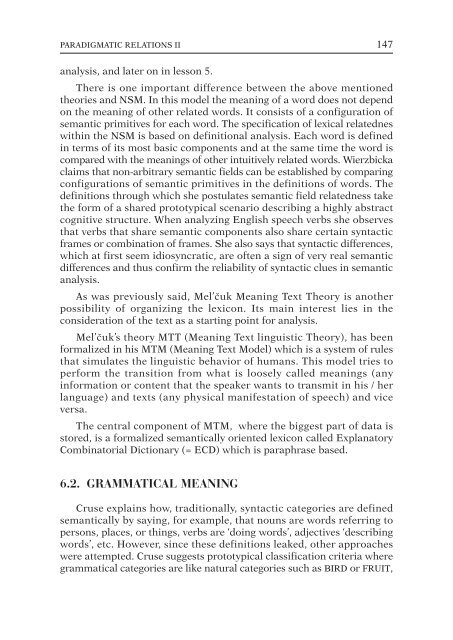Semantics
Create successful ePaper yourself
Turn your PDF publications into a flip-book with our unique Google optimized e-Paper software.
PARADIGMATIC RELATIONS II 147<br />
analysis, and later on in lesson 5.<br />
There is one important difference between the above mentioned<br />
theories and NSM. In this model the meaning of a word does not depend<br />
on the meaning of other related words. It consists of a configuration of<br />
semantic primitives for each word. The specification of lexical relatednes<br />
within the NSM is based on definitional analysis. Each word is defined<br />
in terms of its most basic components and at the same time the word is<br />
compared with the meanings of other intuitively related words. Wierzbicka<br />
claims that non-arbitrary semantic fields can be established by comparing<br />
configurations of semantic primitives in the definitions of words. The<br />
definitions through which she postulates semantic field relatedness take<br />
the form of a shared prototypical scenario describing a highly abstract<br />
cognitive structure. When analyzing English speech verbs she observes<br />
that verbs that share semantic components also share certain syntactic<br />
frames or combination of frames. She also says that syntactic differences,<br />
which at first seem idiosyncratic, are often a sign of very real semantic<br />
differences and thus confirm the reliability of syntactic clues in semantic<br />
analysis.<br />
As was previously said, Mel’čuk Meaning Text Theory is another<br />
possibility of organizing the lexicon. Its main interest lies in the<br />
consideration of the text as a starting point for analysis.<br />
Mel’čuk’s theory MTT (Meaning Text linguistic Theory), has been<br />
formalized in his MTM (Meaning Text Model) which is a system of rules<br />
that simulates the linguistic behavior of humans. This model tries to<br />
perform the transition from what is loosely called meanings (any<br />
information or content that the speaker wants to transmit in his / her<br />
language) and texts (any physical manifestation of speech) and vice<br />
versa.<br />
The central component of MTM, where the biggest part of data is<br />
stored, is a formalized semantically oriented lexicon called Explanatory<br />
Combinatorial Dictionary (= ECD) which is paraphrase based.<br />
6.2. GRAMMATICAL MEANING<br />
Cruse explains how, traditionally, syntactic categories are defined<br />
semantically by saying, for example, that nouns are words referring to<br />
persons, places, or things, verbs are ‘doing words’, adjectives ‘describing<br />
words’, etc. However, since these definitions leaked, other approaches<br />
were attempted. Cruse suggests prototypical classification criteria where<br />
grammatical categories are like natural categories such as BIRD or FRUIT,



